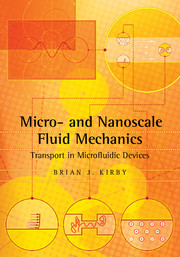Book contents
- Frontmatter
- Contents
- Preface
- Nomenclature
- Introduction
- 1 Kinematics, Conservation Equations, and Boundary Conditions for Incompressible Flow
- 2 Unidirectional Flow
- 3 Hydraulic Circuit Analysis
- 4 Passive Scalar Transport: Dispersion, Patterning, and Mixing
- 5 Electrostatics and Electrodynamics
- 6 Electroosmosis
- 7 Potential Fluid Flow
- 8 Stokes Flow
- 9 The Diffuse Structure of the Electrical Double Layer
- 10 Zeta Potential in Microchannels
- 11 Species and Charge Transport
- 12 Microchip Chemical Separations
- 13 Particle Electrophoresis
- 14 DNA Transport and Analysis
- 15 Nanofluidics: Fluid and Current Flow in Molecular-Scale and Thick-EDL Systems
- 16 AC Electrokinetics and the Dynamics of Diffuse Charge
- 17 Particle and Droplet Actuation: Dielectrophoresis, Magnetophoresis, and Digital Microfluidics
- APPENDIX A Units and Fundamental Constants
- APPENDIX B Properties of Electrolyte Solutions
- APPENDIX C Coordinate Systems and Vector Calculus
- APPENDIX D Governing Equation Reference
- APPENDIX E Nondimensionalization and Characteristic Parameters
- APPENDIX F Multipolar Solutions to the Laplace and Stokes Equations
- APPENDIX G Complex Functions
- APPENDIX H Interaction Potentials: Atomistic Modeling of Solvents and Solutes
- Bibliography
- Index
6 - Electroosmosis
Published online by Cambridge University Press: 05 June 2012
- Frontmatter
- Contents
- Preface
- Nomenclature
- Introduction
- 1 Kinematics, Conservation Equations, and Boundary Conditions for Incompressible Flow
- 2 Unidirectional Flow
- 3 Hydraulic Circuit Analysis
- 4 Passive Scalar Transport: Dispersion, Patterning, and Mixing
- 5 Electrostatics and Electrodynamics
- 6 Electroosmosis
- 7 Potential Fluid Flow
- 8 Stokes Flow
- 9 The Diffuse Structure of the Electrical Double Layer
- 10 Zeta Potential in Microchannels
- 11 Species and Charge Transport
- 12 Microchip Chemical Separations
- 13 Particle Electrophoresis
- 14 DNA Transport and Analysis
- 15 Nanofluidics: Fluid and Current Flow in Molecular-Scale and Thick-EDL Systems
- 16 AC Electrokinetics and the Dynamics of Diffuse Charge
- 17 Particle and Droplet Actuation: Dielectrophoresis, Magnetophoresis, and Digital Microfluidics
- APPENDIX A Units and Fundamental Constants
- APPENDIX B Properties of Electrolyte Solutions
- APPENDIX C Coordinate Systems and Vector Calculus
- APPENDIX D Governing Equation Reference
- APPENDIX E Nondimensionalization and Characteristic Parameters
- APPENDIX F Multipolar Solutions to the Laplace and Stokes Equations
- APPENDIX G Complex Functions
- APPENDIX H Interaction Potentials: Atomistic Modeling of Solvents and Solutes
- Bibliography
- Index
Summary
When electric fields are applied across capillaries or microchannels, bulk fluid motion is observed. The velocity of this motion is linearly proportional to the applied electric field, and dependent on both (a) the material used to construct the microchannel and (b) the solution in contact with the channel wall. This motion is referred to as electroosmosis and stems from electrical forces on ions in the electrical double layer or EDL, a thin layer of ions that is located near a wall exposed to an aqueous solution. If the fluid velocity is interrogated at micrometer resolution, for example, by observation of the fluid flow with a light microscope, the fluid flow in a channel of uniform cross section appears to be uniform. If the fluid velocity is interrogated with nanometer resolution (which is experimentally difficult), we find that the fluid velocity is uniform far from the wall but decays to zero at the wall over a length scale λD ranging from approximately 0.5 to 200 nm. Figure 6.1 illustrates the velocity profile in an electroosmotic flow.
This fluid flow can be immensely useful in microfluidic systems, because it is often much more straightforward experimentally to address voltage signals sent to electrodes rather than to implement and control a miniaturized mechanical pressure pump. This flow, however, comes with its own complications: Its velocity distribution is different from pressure-driven flow, it is sensitive to chemical features at the interface, and the act of applying electric fields can also move particles relative to the fluid or cause Joule heating (i.e., resistive heating) throughout the fluid.
- Type
- Chapter
- Information
- Micro- and Nanoscale Fluid MechanicsTransport in Microfluidic Devices, pp. 131 - 152Publisher: Cambridge University PressPrint publication year: 2010
- 3
- Cited by



